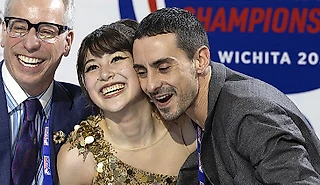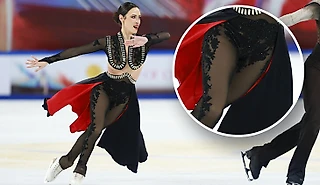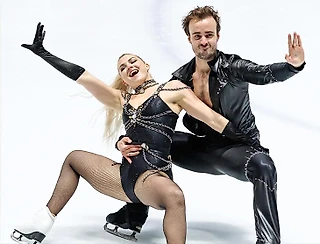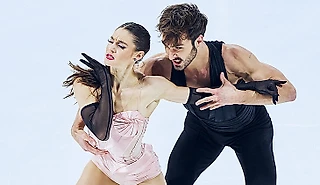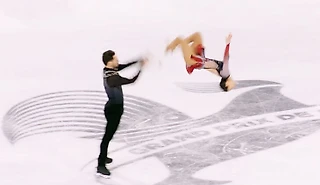Let’s dance 80’s! Revealing new season rhythm dance theme – and so much more. Interview with Shawn Rettstatt from ISU
At the European Championship-2023 in Espoo Sports.ru reporter Maya Bagriantseva had a chance to speak to Mr. Shawn Rettstatt – Chair of ISU Ice Dance Technical Committee.
- Could you tell us when and how do you usually make a decision on the theme for the next season Rhythm dance?
- So for this year – being now the the committee chair – we started much earlier in terms of even the conversations with the coaching and the athlete community. So throughout the whole fall season, even beginning of September through Junior Grand Prix, senior Grand Prix, final and the European’s – we’ve been doing coaches and skater meetings. And of course we start hearing from them what themes for the Rhythm dance they would like to do, what they liked in the past, what they haven’t liked in the past. So it’s really been a nice collaborative work in progress – so that we’re already starting to tell them what the overall theme of next year’s Rhythm dance is going to be, so that we can continue to get more and more feedback and to see what are gonna be the questions now – so we can already get some of that answered.
Because what happens at World’s – is we do an official announcement with the communications following shortly, and we’re trying to get all the communications finalized by that time so that the materials are out much earlier in the season for the athletes. So they’re already in the mix of knowing what the idea is for next year and thinking about it. Everything seems to be super exciting in terms of their response and we’re progressing from that point. So that’s what the committee has been doing here – working on those Communications and we’ll continue to do that until we announce officially at World’s. But that they’ve already been the coaches and athletes have been a huge involvement already.
– There is a feeling that the choice of rhythm dance theme is getting more and more – let’s say – audience oriented. Street dance or musicals must be more popular with the fans that waltz or paso doble. Is that true?
- Yes, totally. The thing is that we have to keep the two programs distinctively different. So that one is a technical based program that is specific in design in terms of the theme. So this year being the Latin rhythms, last year being Street. And the free dance being free so couples can really do everything – from Lady Gaga to classical music.
And for next year what we’ve crafted is music of the 1980s. So the decade of the 80s – to really make it fun and dancy, and also keeping with the fans and the public.
- So the audience could sing along, right?
- Totally :) So we’re definitely trying to incorporate that into making sure that it also stays very much its own separate and very distinct event – keeping the fans engaged.
- Do you like any particular song of that time?
- Everything! I grew up in that period, I was competing nationally and internationally in that time. It’s a great era and there’s so much music to choose from.
And even culturally within different parts of the world. We haven’t said that it has to be just pop – Madonna, Michael Jackson, Cyndi Lauper or Wham. Certain parts of the world had very distinctive music – and that’s completely fine as well. In the end it’s all about creating a dance program. And if they pick music that the officials can’t understand as dance music, the audience can’t understand as dance music – then they probably haven’t picked the right piece of music.
So even if we’ve never heard the piece of music before if it’s from the 1980s and it’s dance music (since it is the Rhythm Dance program) – it’ll be translatable to any country. You’ve got a lot of stuff to choose from which I think think would be quite fun. That’s what we’re hopeful for.
- When you are changing the technical requirements, do you also consult with the coaches?
- Sure, they have been completely involved, this year in particular. We started early in the fall, in the winter and through now – throwing out ideas and then teams throwing us ideas.
In fact one of the changes to one of the elements next year in the Rhythm dance has been direct responsive feedback and ideas that have gone back and forth between our meetings with them, and the coaches and the athletes giving us feedback back. «Yes, no, this works, that doesn’t work» – that kind of stuff.
My goal is to have a true collaboration. We won’t satisfy everyone all the time, but much of it is a collaboration so that the end result they have also had ownership in – so that when they hear the official it’s something that they are also excited about because they were part of the process.
- Have you ever had negative feedback on any technical requirements?
- Oh, sure. And it’s not necessarily that it’s negative. But sometimes the questions are good because it brings stuff that we didn’t think of to the forefront. Something that we didn’t think could be an issue once the season actually starts – so that’s all good. And that’s why we’ve been trying to get more and more of the conversation earlier to get all of those questions answered sooner. So that once the material goes out – it doesn’t have to be redone, changed and adjusted.
- So there is some flexibility in that, right?
- The way it works is that the first two years after an Olympic cycle is our time to try out new things – whether it’s new elements, new theme ideas, like next year being music of the 80s. So that when we get to year three and four we have everything in place and locked in – so no new inventive things come up those two years. This way everybody can get used to what the elements are going to be in both the Rhythm dance and the free dance. And then after the Olympics we can kick back in with the new ideas again.
- But then there must be some kind of teaching seminars for the judges and technical specialists – so they know how to tell a slide from a fall.
- Oh, those happen continually year after year. And that’s one thing that I started this year and what I will expand next year into the judges and the coaching community. We actually started pre-event calls with the tech panels and referees of the junior grand prix and senior Grand prix – just to have that time to answer questions, hear concerns about how to call this and how to call that (because we added a new element).
And that was a really good way that everybody at all those elements could share their experiences, and that helped the committee through the year figure out what needs to be changed for the next year in terms of adjusting some of the requirements to make it more clear for both the coaches, for the judges and for the athletes.
- So any chance pattern dance will be coming back?
- Most likely it will always stay in Juniors and below because it’s very developmental. But we’ve been doing some very interesting ideas in the last couple of years with the pattern dance in junior and below as well.
Next year the pattern dance element for Junior in particular – Sequence 1 – will be the traditional steps (the woman doing the woman steps, the man doing the man steps). But with Sequence 2 we’re doing the opposite. So the man will execute the woman’s steps and the woman will execute the man steps. And with open holds they’ll be able to be creative with their holds.
It’s a new idea to freshen it up a little bit – and still be the same dance, but with the steps being done by the other partner for the second pattern of the dance.
- But not for adults?
No, for seniors we’re creating a «Pattern Dance Choreographic Element». So you will still have a pattern dance – and I should say once again that so far it’s not official yet – but in the discussion we will put a pattern dance Choreographic element into the Rhythm dance, so it will still be a pattern dance that you will recognize – but it will not necessarily have levels. It will have a choreographic approach to it being judged as a Choreo element. So something new – we’ll see how that works.
This year we did the Choreo step in the Rhythm dance and next year will be this Choreo pattern dance and then we’ll see what worked. We’ll have two years of how it worked and what the feedback is – first and foremost from the athletes, to see if it’s a fun element for them to do choreographically. Our feedback before was the juniors and their coaches wanted to keep the pattern dance because of the development, but the seniors... They’re not opposed to pattern dance, but they didn’t want it to necessarily be levels – to give them more creativity and freedom. And that’s why we’ve started discussing this idea.
- Do teams have a chance to meet technical committee specialists and ask some questions before the season?
- Each country has their own method of how that happens internally – with their developmental camps or preseason camps. And then the technical specialists (already pre-trained) can be invited there and share their opinion.
Next year (and we have already started it this season with the tech panels and referees) we will have pre-event meetings with the coaching community and with the judging community so that we can have more feedback to what’s coming, what’s the changes of the elements – because not every country can hold a true seminar on the matter.
We’re also very familiar with Zoom and are able to connect all the world – whether it’s been Zoom judging or Zoom seminars (like I’ve been doing ones for China).
- What about judges from the countries that are currently banned? Like Russia or Belarus.
- They have access to all of the information and materials via the website. Everything is available to them – all of the e-learning or materials for the annual recertification exams. That’s all available to them.
- In your opinion – an opinion of a very experienced ice dance professional – how long does it take for a newly made team to become a real duet on the ice? This is quite a topical issue for today’s Russian ice dance...
- It varies from a couple of couple - I’ve seen a couple that is brand new this year that you wouldn’t have ever guessed that, and the woman in particular never ice danced before. And then in another couples it takes a couple of years to finally get «the gel». So it’s all based on the chemistry of the couple themselves. Certainly there is also the quality of the training and of course the quality of the background of those two partners because they could be even coming from different backgrounds of skating and training. So merging those together can sometimes be even harder of a challenge than anything – just because the technique is so different between where they came from. So it varies from team to team.
- Last – and not very serious question. There are always technical panel people present at official ice dance practices at the events. What’s the purpose of that?
- We have started to have that discussion with the judges – if they need to be there.The technical panel and of course the referee who is responsible for the event really need to be present – to see the elements and to understand what the couple is attempting to execute. So that when they are actually in the program, we already have an understanding of what features they’re trying to do – to do the levels.
And even here in Espoo with all the practices scheduled here – we still had many couples that we never saw several of their elements at all. So it’s just to be able to have a simple understanding of what they’re attempting.
- So if something goes wrong in the competition you have an understanding what element was supposed to be there?
- No, in terms of technical paneling you still evaluate what you see on the day of the competition. And it is the same for the judges.
They do need to come to practices because it’s more than just watching the performance. It’s making sure that the music is correct, and in ice dance that’s a huge piece of the Rhythm dance part. As well as for the free dance because it has to have the change of tempo etc. So part of it is that they just need to hear the music as well.
But we’ve tossed around the idea that maybe on the day off they don’t come to practices anymore. So that the skaters don’t have to be up at 4 AM, you know putting on hair and makeup and getting ready. But to be honest it’s also part of the ice dance culture – I did it when I competed. I was fully dressed and ready to go at 7:00 am and I wasn’t just in practice clothes. And there are some competitions (on regional level) that are not as big as this event in Espoo (where we had six official dance practices) – and you don’t have any practice there. The first time you see the couple is literally at the event.
But maybe there’s a way that we can slowly tweak that a little bit so that the teams don’t have to be in full hair and makeup, in their competition costume in every practice. And maybe the officials don’t have to also be at every practice. It’s one of our conversations we’ve been having with the skaters and the coaches to see – okay, how can we do.


